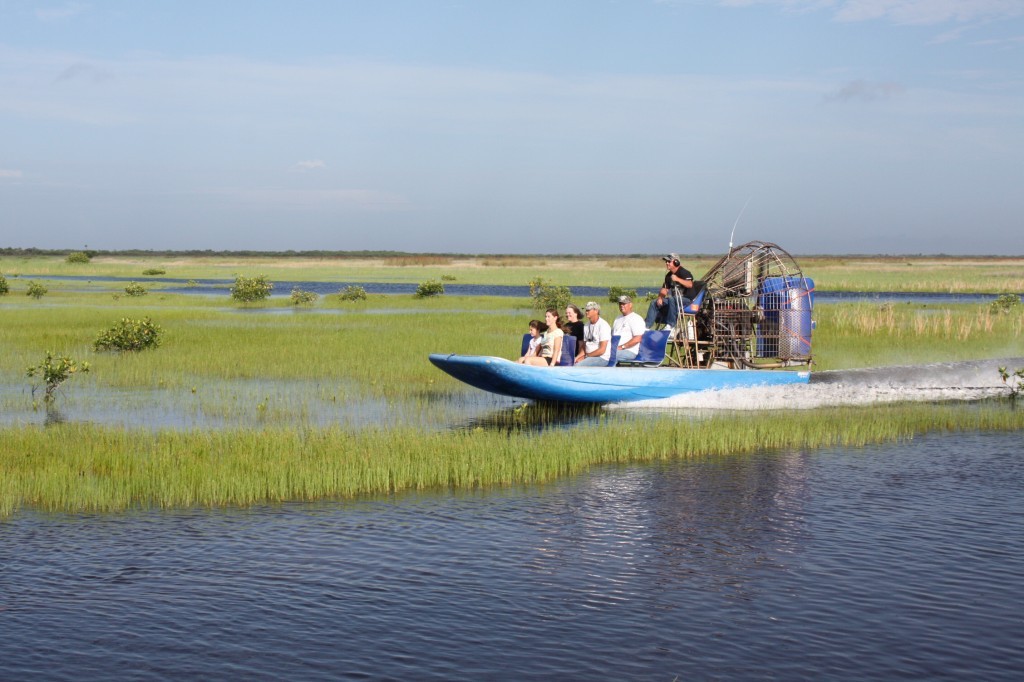
Airboats aren’t like other boats. They are able to glide through shallow waters and they work particularly well in marshy areas like the Florida Everglades and Louisiana Bayous. Why? Well, they have a flat-bottom design combined with an above-water aircraft propeller.
Originally, airboats served as a primary mode of transportation throughout the Everglades, and now they’re commonly used for recreational activities like hunting, fishing and wildlife viewing.
In 1942, Barrel Head House built one of the first commercial airboats. Since then, Everglades visitors enjoyed skimming above the water’s surface. Tourists and locals enjoy airboat tours for the chance to sight alligators, birds, turtles and other popular Everglades wildlife.
Over the years, airboat rides and tours quickly became a staple in Everglades ecotourism, and to this day they are of the most popular attractions in South Florida.
Parts of an Airboat
An airboat is intricate. Below, we have listed some parts of an airboat.
- Engine: airboats call for an aircraft or automotive V8 engine ranging from 500 to 600+ horsepower.
- Propeller: an aircraft propeller operates out-of-water to power an Everglades airboat.
- Propeller cage: the propeller sits inside a metal cage, which protects the boat and its inhabitants from injury.
- Rudder panels: steering airboats relies heavily on rudder panels, which help direct air.
- Rudder stick: located on the airboat driver’s left side, the rudder stick directs the boat through the swamp.
- Accelerator: the captain uses the accelerator to gain speed during airboat rides.
Book an Airboat Tour in the Everglades
Did you know Captain Mitch’s Everglades Airboat Tours in Everglades City, is the oldest airboat tour provider in the Everglades? For generations, Captain Mitch and company have delivered safe, fun and family-friendly excursions throughout South Florida wilderness.
To schedule your private Everglades ride, contact Captain Mitch’s Everglades Airboat Tours at 239-695-3377 or click Everglades airboat tour page.
Captain Mitch’s Everglades Private Airboat Tours is open 7 days a week from 8:30 a.m. to 4:30 p.m. If paying by cash, adults cost $40 (plus tax) and children 12 and under cost $20 (plus tax. If paying by credit card, adults cost $45 (plus tax) and children cost $25 (plus tax).
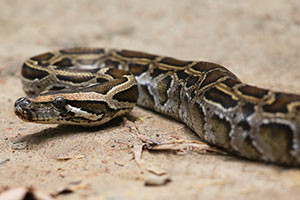 At this point, pythons are notoriously known to be bad news for the Everglades. They are an invasive species as they deplete mammal populations. Each year, pythons hunts are held to reduce the number of this species in the Everglades to try and help bring balance back to the ecosystem of the Everglades. Now, researchers are saying the Burmese pythons are eating/killing so many animals in the Everglades that mosquitos are starting to bite the hispid cotton rat that carries a virus that is dangerous to humans.
At this point, pythons are notoriously known to be bad news for the Everglades. They are an invasive species as they deplete mammal populations. Each year, pythons hunts are held to reduce the number of this species in the Everglades to try and help bring balance back to the ecosystem of the Everglades. Now, researchers are saying the Burmese pythons are eating/killing so many animals in the Everglades that mosquitos are starting to bite the hispid cotton rat that carries a virus that is dangerous to humans.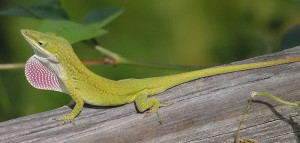 Crawling all over the Everglades’ trees and floors are reptiles. More than 50 distinct kinds of reptiles live in the Park. The Park’s most well-known reptiles are, of course, the American alligator and the American crocodile, but there’s plenty of other scaly creatures running around, including the very tiny green anole (anolis carolinensis).
Crawling all over the Everglades’ trees and floors are reptiles. More than 50 distinct kinds of reptiles live in the Park. The Park’s most well-known reptiles are, of course, the American alligator and the American crocodile, but there’s plenty of other scaly creatures running around, including the very tiny green anole (anolis carolinensis). Animals. Insects. Reptiles. Amphibians. Plants. Water. Airboats. These are a list of things that you may easily see on your trip to the Everglades. However, did you know you can also see artwork in the middle of this beautiful wetland? It’s true.
Animals. Insects. Reptiles. Amphibians. Plants. Water. Airboats. These are a list of things that you may easily see on your trip to the Everglades. However, did you know you can also see artwork in the middle of this beautiful wetland? It’s true.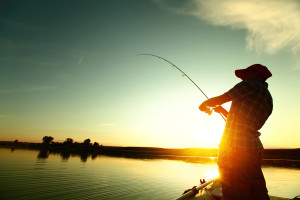 Love to fish? The Everglades is a great spot to do it, since one-third of this place is covered by water! Throughout the park, there are many acres of shallow water flats, mangrove keys, and channels that make great spots to fish! However, fishing from the shore is limited. In the state of Florida, there are specific freshwater and saltwater licenses and regulations to follow. For important fishing information, click
Love to fish? The Everglades is a great spot to do it, since one-third of this place is covered by water! Throughout the park, there are many acres of shallow water flats, mangrove keys, and channels that make great spots to fish! However, fishing from the shore is limited. In the state of Florida, there are specific freshwater and saltwater licenses and regulations to follow. For important fishing information, click 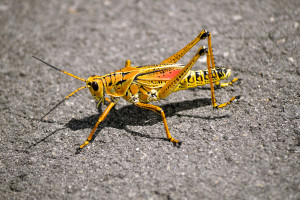 When you think of wildlife in the Everglades, what comes to mind? Alligators? Panthers? Majestic birds? How about insects? Well, they should, because there’s thousands of them flying and crawling around this ecosystem. One such insect that calls the Everglades home is the lubber grasshopper.
When you think of wildlife in the Everglades, what comes to mind? Alligators? Panthers? Majestic birds? How about insects? Well, they should, because there’s thousands of them flying and crawling around this ecosystem. One such insect that calls the Everglades home is the lubber grasshopper.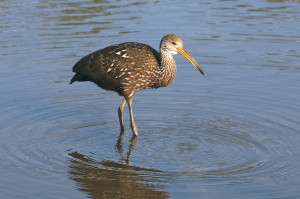 At certain times of the year, the Everglades can look like a scene out of Alfred Hitchock’s The Birds. Thousands of birds flock down to this warm climate to spend the winter and breed. For this article, we wanted to spotlight one species of bird that can be found in the Everglades: the Limpkin. This bird can actually be found in the Everglades year-round.
At certain times of the year, the Everglades can look like a scene out of Alfred Hitchock’s The Birds. Thousands of birds flock down to this warm climate to spend the winter and breed. For this article, we wanted to spotlight one species of bird that can be found in the Everglades: the Limpkin. This bird can actually be found in the Everglades year-round. One of the most overlooked aspects of Mother Nature can be found right overhead. Look, up there in the sky!
One of the most overlooked aspects of Mother Nature can be found right overhead. Look, up there in the sky!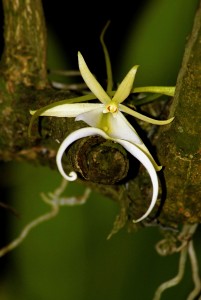 The Ghost Orchid is one of the Everglades’ most rare and endangered plants.
The Ghost Orchid is one of the Everglades’ most rare and endangered plants.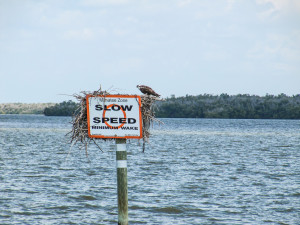 The Everglades is a 1.5 million-mile-acre wetland preserve, which means there’s a lot of land and water for you to explore. Being a fragile ecosystem and National Park filled with thousands of creatures and plant life, there are several regulations that must be followed when spending time here. The Everglades provides shelter to many species, and it also provides water to southern Florida, so it is important for visitors to respect this environment. If you’re planning a trip to the Everglades, we wanted to share with you some important regulations to keep in mind.
The Everglades is a 1.5 million-mile-acre wetland preserve, which means there’s a lot of land and water for you to explore. Being a fragile ecosystem and National Park filled with thousands of creatures and plant life, there are several regulations that must be followed when spending time here. The Everglades provides shelter to many species, and it also provides water to southern Florida, so it is important for visitors to respect this environment. If you’re planning a trip to the Everglades, we wanted to share with you some important regulations to keep in mind.





